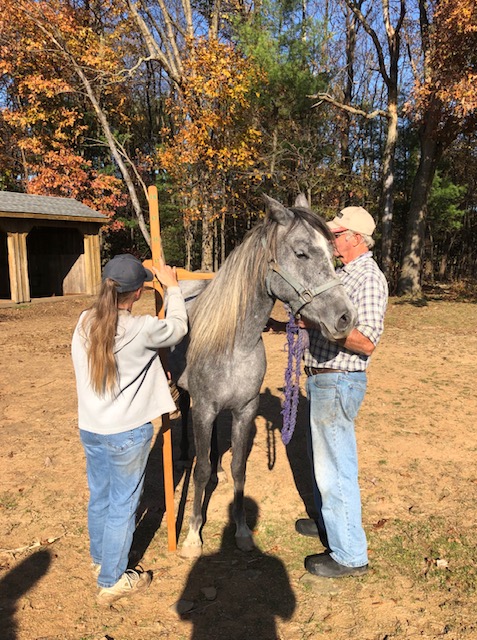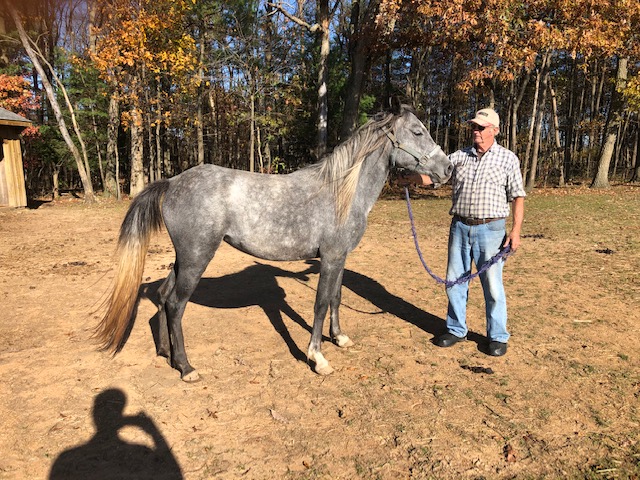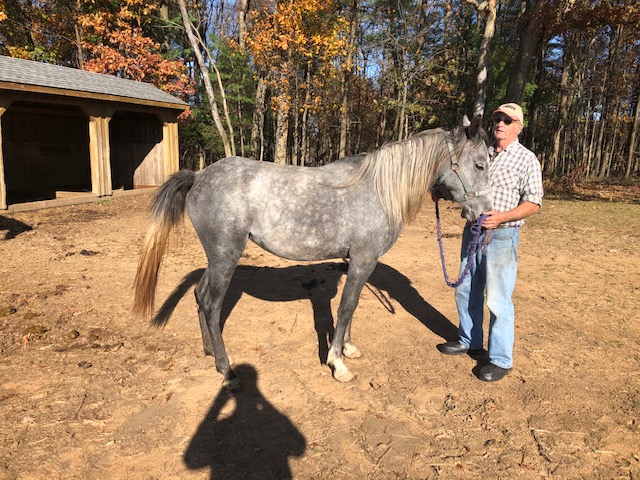Little Barakah is now three
Another surprise from this past week’s visit to my horses was little Barakah (Wadd Al Arab x Jadah BellOfTheBall). She is now three years old. I left her a little filly. She is now a young mare who cycles and all. She measured at just above 14 hands, which is a good size for this age.
She has a deeper girth than her dam and a straighter back. That’s her sire Wadd’s influence. But she lost her dam’s beautiful level croup and inherited instead her sire’s short slopey croup and short hip (which Wadd in turn inherited from his dam Wisteria CF). She also has attitude, unlike her dam. She may outgrow some of that, and still has a lot of growing to do.




Since you didn’t ask my opinion, I will give it anyway! I believe it is a mistake to judge immature animals, as so much changes as they reach athletic and reproductive maturity. I remember Barakah well from about 18 months ago, and I liked her very much. I fully expect to like her very much as an adult.
You are right, but i still see elements of similarity with mature relatives
I had to go find photos of her sire and dam for comparison, but I do think some of that croup and hip will correct itself as she grows. (I also think that her hindquarters remind me more of her dam than her sire, but I have only seen her and them in photos, which can be misleading.) I am sure, though, that she will be lovely when she is mature.
Doesn’t she stand under her? as if her hing legs are pulled forward? Honest feedback welcome please. I need to make a decision on whether i stick to these old American lines, or whether I need to change directions: e.g., importing new Syrian, Bahraini, Saudi, and/or Tunisian lines.
Honestly, it’s hard to say how she’s standing, beyond the fact that she looks like she’s fidgeting. Plus, what experience I have with young horses cautions me against judging their conformation too harshly, after I watched one cute colt turn into an incredibly ugly yearling, and then, one day, when passing his field, I discovered that the incredibly ugly yearling had turned into a very handsome young horse.
I agree that Barakah has a deep girth, and her withers run quite far into her back, though between her enviably long mane and her fidgeting, it is hard to get a good look at her shoulder. I also agree that I am not thrilled by her hind end right now, but again, looking at both of her parents, it should improve; her actual hip length is not too bad, but the current prominence of the tuber coxae keeps pulling the eye backwards, so that the hip looks shorter. Also, if she does keep a steeper pelvic angle she will at least be able to get her hind legs underneath her more easily!
Re standing with the hind legs forward, she’s also leaning over her front feet in the last one, where her hind legs are most underneath her, so that’s not exactly the best of postures to judge by. In the second and third photos, she’s standing better up front, and what I think I’m seeing there is actually a butt-high baby in the middle of a growth spurt, as she looks a little taller behind than in front. Having just been through the 3yo year with youngster here, all I can say is that it is a year where she grew weirdly (in her case, she grew loooong and then she’d grow up), so, again, you may just have caught Barakah at an awkward time. Besides, exercise does wonders for a horse’s physique and posture – you should see how Abba looked at age six and how she looks now that we have tackled her postural issues through exercise and strengthening the correct muscles. She even grew a little, because her thoracic sling was strengthened, which meant that her withers stood higher.
Also, you could always keep on with the Davenports but introduce fresh blood as well. The problem with western Arabians is that their gene pool is very small and very closed, whilst the cradle country horses have a striking amount of genetic diversity, according to Khanshour et al. 2013 ‘Microsatellite Analysis of Genetic Diversity and Population Structure of Arabian Horse Populations’ J. Hered. 104(3):386–398. And whilst there is value to breeding ‘straight’ and preserving specific bloodlines in specific closed breeding groups, there is also value in renewing the connection to the countries of origin. I suppose it depends on what it is exactly that you want to do, and which horses make you happy.
For tuber coxae, please read tuber sacrale!
I agree with Kate. For genetic health and diversity of the breed, fresh blood is always welcome!
Experienced old time breeders can tell how the foal will look like when matured.
It can save time and money.
Bassam, I think I have seen more young horses grow up than most, and believe me, we could not always tell. If we there at the moment of delivery, we started a video rolling in our heads that we added to as the foal grew. We learned to judge, but cautiously, and always, always, allow for the conditions that foal is going through. Nature and nurture! Can’t discount that latter!
I have heard that you can see something of what you have (or will have) when the foal is first born, laying in the straw or wherever, before they begin to use their muscles to do anything . . . stand, nurse etc – an idea so to speak but after that everything changes and you are then in the waiting game. I guess you gotta be there at the right moment and not only that, have the eyes to see.
i have heard that too.
Edouard, my suggestion might be to continue with the Davenports, but it would not be remiss to introduce new blood. You’ve long expressed your admiration for them as a breeding group, and I imagine a judicious introduction of stallions, Syrian or otherwise, might bring much to the table.
After all, look what a little bit of Bahraini infusion did to the stallion Kibriya Nishkur’s otherwise heavily Nazeer-saturated pedigree.